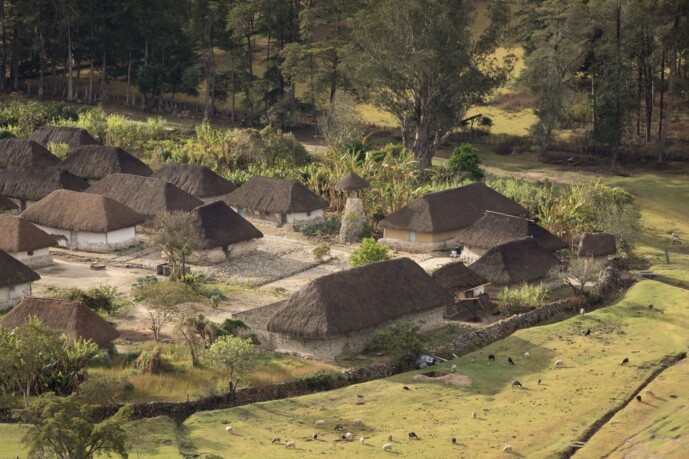Nabusimake
Nabusimake, the sacred heart of the Arhuaco indigenous people in Colombia, offers a serene escape into the Sierra Nevada’s lush landscapes and rich cultural traditions.

Nestled in the Sierra Nevada de Santa Marta, Nabusimake is the spiritual heart of the Arhuaco indigenous people. This sacred village offers a rare glimpse into ancient traditions, breathtaking mountain landscapes, and serene simplicity. Visitors come to connect with nature, learn from indigenous wisdom, and trek through Colombia’s untouched highlands—a truly transformative escape from modern life.
Essentials
- Best Months to Visit: December, February, January
When to visit
Seasonal Weather Patterns
Nabusimake, nestled in the Sierra Nevada de Santa Marta, enjoys a mild climate year-round due to its high-altitude location. However, there are distinct seasonal variations that can influence your travel plans:
- Dry Season (December to March): This is the most popular time to visit, with sunny days and cooler nights. Daytime temperatures hover around 18-22°C (64-72°F), making it ideal for hiking and exploring the sacred sites of the Arhuaco people.
- Rainy Season (April to November): Rainfall peaks between September and November, which can make trails slippery and transportation more challenging. However, the landscape is lush and vibrant, offering a unique perspective of the region’s natural beauty.
Major Events and Cultural Highlights
Timing your visit around local events can provide deeper insight into the Arhuaco culture and traditions:
- January: The Arhuaco New Year celebrations, marked by rituals and ceremonies, offer a rare glimpse into their spiritual practices. Visitors should approach with respect and seek permission before participating.
- June: The summer solstice is another significant time, with traditional dances and offerings to the sacred mountains.
Other Key Factors
Beyond weather and events, consider these practical aspects when planning your trip:
- Crowds: The dry season attracts more tourists, so expect higher prices and busier trails. For a quieter experience, consider the shoulder months of November or March.
- Accessibility: Roads to Nabusimake can be rough, especially during the rainy season. Four-wheel-drive vehicles are recommended, and some routes may require local guides.
- Permits: As a sacred indigenous territory, visitors often need permission from the Arhuaco community. Plan ahead and arrange this through authorized tour operators.
What to pack
Nabusimake, nestled in Colombia’s Sierra Nevada de Santa Marta, demands thoughtful packing due to its high-altitude climate and indigenous cultural significance. The weather here shifts rapidly—mornings can be chilly, while afternoons turn warm. Pack layers, including a lightweight fleece or windbreaker, and moisture-wicking clothing for hikes to sacred sites like the Lost City.
- Sturdy hiking boots: Trails are rugged and often muddy, especially during the rainy season.
- Reusable water bottle with purification tablets: Clean water sources are limited, and single-use plastics are discouraged.
- Respectful attire: The Arhuaco people value modesty—avoid shorts or revealing clothing when visiting their villages.
- Cash in small denominations: ATMs are nonexistent, and local vendors prefer bills over large notes.
- Solar-powered charger: Electricity is unreliable, and charging ports are scarce in remote areas.
Don’t forget insect repellent—mosquitoes are persistent at lower elevations—and a compact umbrella for sudden downpours. A small offering, like coca leaves or handmade crafts, is appreciated when engaging with the Arhuaco community.
Culture
Indigenous Heritage and the Arhuaco People
Nabusimake, known as the “Heart of the World” by the Arhuaco people, is a sacred settlement in Colombia’s Sierra Nevada de Santa Marta. The Arhuaco, one of four Indigenous groups in the region, maintain deep spiritual ties to the land, guided by Mamos (spiritual leaders) who uphold ancestral traditions. Their worldview centers on harmony with nature, symbolized by the poporo (a ceremonial gourd) and mochila (handwoven bags), which represent cultural identity.
Language and Oral Traditions
The Arhuaco speak Ika, a Chibchan language, though Spanish is used for external communication. Oral traditions, including myths and moral teachings, are passed down through generations. Stories often emphasize the Sierra Nevada as a living entity, with rivers and mountains considered sacred beings.
Traditional Governance and Social Structure
Nabusimake operates under a traditional governance system led by the Mamos, who mediate conflicts and oversee rituals. Decisions are collective, reflecting communal values. The cabildo (council) ensures cultural preservation, while men and women have distinct roles—men often train as spiritual leaders, while women manage agriculture and weaving.
Rituals and Spiritual Practices
- Pagamentos (Offerings): Ceremonies to “pay” nature for resources, involving coca leaves, seashells, and woven artifacts.
- Coming-of-Age Rites: Boys undergo isolation and teachings to become Mamos; girls learn weaving and household duties.
- Dance and Music: Drums and flutes accompany rituals, often honoring the sun, moon, and sacred sites.
Economy and Sustainability
The Arhuaco practice subsistence farming (corn, beans, and coca) and barter with neighboring communities. Their economy is deeply ecological, rejecting mining and deforestation. Handicrafts like mochilas and beaded jewelry sustain livelihoods while preserving symbolism.
Challenges and Modern Influences
Despite resistance to assimilation, the Arhuaco face pressures from armed groups, climate change, and tourism. Efforts to document their language and legal battles for land rights highlight their resilience in protecting cultural autonomy.
History
Nabusimake, known as the “Heart of the World” by the Arhuaco indigenous people, is a sacred village nestled in the Sierra Nevada de Santa Marta mountains of Colombia. It serves as the spiritual and political center of the Arhuaco community, who have preserved their traditions and connection to nature for centuries. The village remains a symbol of indigenous resilience and cultural heritage.
Important Dates
- Pre-Columbian Era: The Arhuaco people inhabited the Sierra Nevada de Santa Marta long before Spanish colonization.
- 16th Century: Spanish conquest disrupted indigenous communities, but the Arhuaco resisted assimilation.
- 20th Century: Nabusimake became a focal point for Arhuaco governance and cultural preservation.
- 1982: The Arhuaco officially declared Nabusimake their capital, reinforcing autonomy.